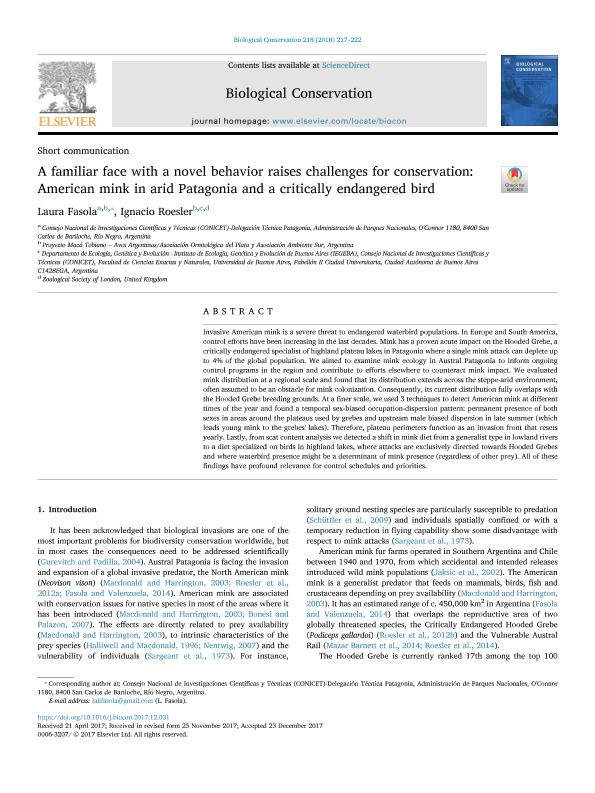Mostrar el registro sencillo del ítem
dc.contributor.author
Fasola, Laura

dc.contributor.author
Roesler, Carlos Ignacio

dc.date.available
2020-02-03T20:15:38Z
dc.date.issued
2018-02
dc.identifier.citation
Fasola, Laura; Roesler, Carlos Ignacio; A familiar face with a novel behavior raises challenges for conservation: American mink in arid Patagonia and a critically endangered bird; Elsevier; Biological Conservation; 218; 2-2018; 217-222
dc.identifier.issn
0006-3207
dc.identifier.uri
http://hdl.handle.net/11336/96581
dc.description.abstract
Invasive American mink is a severe threat to endangered waterbird populations. In Europe and South America, control efforts have been increasing in the last decades. Mink has a proven acute impact on the Hooded Grebe, a critically endangered specialist of highland plateau lakes in Patagonia where a single mink attack can deplete up to 4% of the global population. We aimed to examine mink ecology in Austral Patagonia to inform ongoing control programs in the region and contribute to efforts elsewhere to counteract mink impact. We evaluated mink distribution at a regional scale and found that its distribution extends across the steppe-arid environment, often assumed to be an obstacle for mink colonization. Consequently, its current distribution fully overlaps with the Hooded Grebe breeding grounds. At a finer scale, we used 3 techniques to detect American mink at different times of the year and found a temporal sex-biased occupation-dispersion pattern: permanent presence of both sexes in areas around the plateaus used by grebes and upstream male biased dispersion in late summer (which leads young mink to the grebes’ lakes). Therefore, plateau perimeters function as an invasion front that resets yearly. Lastly, from scat content analysis we detected a shift in mink diet from a generalist type in lowland rivers to a diet specialized on birds in highland lakes, where attacks are exclusively directed towards Hooded Grebes and where waterbird presence might be a determinant of mink presence (regardless of other prey). All of these findings have profound relevance for control schedules and priorities.
dc.format
application/pdf
dc.language.iso
eng
dc.publisher
Elsevier

dc.rights
info:eu-repo/semantics/openAccess
dc.rights.uri
https://creativecommons.org/licenses/by-nc-sa/2.5/ar/
dc.subject
American mink
dc.subject
invasive species
dc.subject
diet
dc.subject
Patagonia
dc.subject.classification
Conservación de la Biodiversidad

dc.subject.classification
Ciencias Biológicas

dc.subject.classification
CIENCIAS NATURALES Y EXACTAS

dc.title
A familiar face with a novel behavior raises challenges for conservation: American mink in arid Patagonia and a critically endangered bird
dc.type
info:eu-repo/semantics/article
dc.type
info:ar-repo/semantics/artículo
dc.type
info:eu-repo/semantics/publishedVersion
dc.date.updated
2019-10-09T20:43:24Z
dc.journal.volume
218
dc.journal.pagination
217-222
dc.journal.pais
Países Bajos

dc.journal.ciudad
Amsterdam
dc.description.fil
Fil: Fasola, Laura. Proyecto Macá Tobiano; Argentina. Administración de Parques Nacionales; Argentina. Consejo Nacional de Investigaciones Científicas y Técnicas; Argentina
dc.description.fil
Fil: Roesler, Carlos Ignacio. Consejo Nacional de Investigaciones Científicas y Técnicas. Oficina de Coordinación Administrativa Ciudad Universitaria. Instituto de Ecología, Genética y Evolución de Buenos Aires. Universidad de Buenos Aires. Facultad de Ciencias Exactas y Naturales. Instituto de Ecología, Genética y Evolución de Buenos Aires; Argentina. The Zoological Society Of London; Reino Unido. Proyecto Macá Tobiano; Argentina
dc.journal.title
Biological Conservation

dc.relation.alternativeid
info:eu-repo/semantics/altIdentifier/doi/https://doi.org/10.1016/j.biocon.2017.12.031
dc.relation.alternativeid
info:eu-repo/semantics/altIdentifier/url/https://www.sciencedirect.com/science/article/pii/S000632071730695X
Archivos asociados
